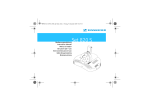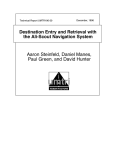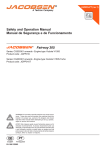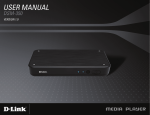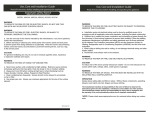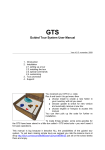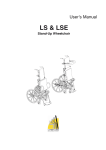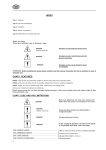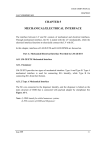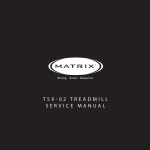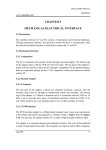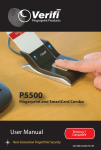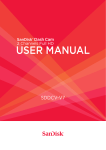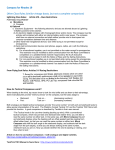Download Test Plans PDF
Transcript
P14031 Test Plan Summary Spec # Metric/Specification Units Marginal Target S1 S2 S3 S4 S5 S6 S7 S8 S9 S10 S12 S13 S14 Transfer time User reach distance to jib lines Does design only contain mechanical parts? Distance between existing bench and seat Does design require boat modification? Is fixture permanently fastened to boat? Device Weight Device displacement from secured position Number of potential pinch points User's unobstructed field of view (compared to no device use) Does the user have the option to secure their limbs? Time to get into seat Time to get out of seat sec in yes/no mm yes/no yes/no lbs in count % yes/no min min 5 25 Yes 200 No No 100 2 5 75 Yes 5 5 2 15 Yes minimize No No 50 0 0 100 Yes 2 2 ↓ ↓ X ↓ X X ↓ ↓ ↓ ↑ X ↓ ↓ TP1 TP2 TP3 TP4 TP3 TP3 TP5 TP6 TP7 TP8 TP3 TP9 TP9 S15 Weight capacity lbs 220 265 ↑ TP10 S16 S17 S18 S19 S20 S21 S22 Are all components chosen for corrosion resistant properties? Time to install device in Sonar Number of installation steps Max horizontal distance from boat centerline Degrees of rotation Vertical distance between seat and boom Number of parts requiring specialized equipment to manufacture. Number of custom parts used in design (custom parts cannot be purchased 'off-the-shelf' in a store or online) Time to remove device from Sonar Number of steps to uninstall device % of users who find seat "comfortable" Depth of plywood groove after 13500 rotations (~5 years) yes/no min count in degrees in count Yes 20 10 21 +/- 30 33 5 Yes 5 5 24 +/-45 38 0 X ↓ ↓ ↑ ↑ ↑ ↓ TP3 TP11 TP11 TP12 TP13 TP14 TP15 count 5 0 ↓ TP15 min count % in 20 10 60 0.23 5 5 75 0.10 ↓ ↓ ↑ ↓ TP16 TP16 TP17 TP18 S23 S24 S25 S26 S27 KEY - TEST RESULTS X Δ O Does not meet expectation Caution-Undetermined if specification is met Meets specification Direction Test Plan Sonar Needed X X Sailing Req'd X X X X X X X X X X X X X X X X Actual Concluded Condition 3 sec 19" Yes 6" (152.4 mm) No No 51 lbs 0.75" 0, but there is 1 trip hazard 100% Yes dependent on disability dependent on disability O O O O O O O O O O O Δ Δ 215 lbs (ANSYS simulation shows failure at ~300 lbs, but team could not test to device failure) Δ Yes 4.5 minutes 6 steps 23" +/- 90 34.5" 1 part O O O O O O O 1 part X X X 2.5 minutes 6 steps Mfgr chooses seat that fits needs depth = 0.025 in O O O Δ O Test Plan # 1 (TP1) - Transfer time between port and starboard Back to P14031 Test Plan Summary Test Team: Test Location: Test Date: I. TESTING SPECIFICATION Specification Number Risk Specification Units Marginal Value Target Value Comments/Status S1 LOW Transfer time sec 5 2 Cannot test until device is fully built II. EQUIPMENT/CONDITIONS REQURIED Specification Number S1 Equipment or Instrumentation required Completed Jib Transfer System Sonar Sailboat Stopwatch Testing Conditions Test under real sailing conditions - while on the water in order to obtain most accurate measurements. If these conditions are not available then it is possible to complete the test while stationary (test will show device does rotate; however, will provide unreliable results for transfer time conclusion) III. DATA COLLECTION STRATEGY Specification Number S1 Data Acquisition Strategy Conducting a time study will allow us to determine the time it takes to move the user between port and starboard. The transfer time is important because the user needs to be able to switch sides relatively quickly to maintain the appropriate weight distribution. IV. TESTING FLOWCHART Gather required instrumentation for testing Position user into the jib transfer system (position over bench in locked position) Before the tack, the user will swing to the other side; time this motion Record the time, in seconds V. RESULTS The device was tested at a 15 degree heel angle and the results show approximately 3 second transfer time VI. MITIGATION PLAN (IF NEEDED) N/A VII. CONCLUSION The user will be able to transfer between port and starboard in an appropriate amount of time in order to maintain weight distribution Repeat the time measurement 10 times total Test Plan # 2 (TP2) - Reach Distance to Jib Lines Back to P14031 Test Plan Summary Test Team: All Test Location: Rochester Yacht Club (device installed in Sonar) Concluded Condition Test Date: 4/23/14 O I. TESTING SPECIFICATION Specification Number Risk Level Specification Units Marginal Value Target Value Comments/Status S2 MED User reach distance to jib lines in 25 15 Cannot complete test until device is fully built II. EQUIPMENT/CONDITIONS REQURIED Specification Number S2 Equipment or Instrumentation required Completed Jib Transfer System Sonar Sailboat Tape Measure Testing Conditions None - Test can be completed while Sonar is out of water III. DATA COLLECTION STRATEGY Specification Number S2 Data Acquisition Strategy Measuring the maximum distance from the seat to the jib lines will allow the team to conclude that the jib system allows the user to reach the existing jib lines. We want the distance the user has to reach, in order to hold the jib lines, to be comfortable and not cause an excessive strain on their body. IV. TESTING FLOWCHART Position the jib transfer system (position over port-side bench in locked position) Gather required instrumentation for testing Measure the distance from the edge of the seat to the jib lines on the bulkhead Record the distance, in inches Unlock the seat and swing to the starboard side (locking it in position over the bench) V. RAW DATA ACQUISITION Port-side locked position Starboard locked position Distance 19" 19" VI. RESULTS The distance for the user to access the jib lines is the same from both port and starboard locked positions, at 19" VII. MITIGATION PLAN (IF NEEDED) If the jib lines are not accessible by the user then the team can consider two options: 1) Moving the device more forward in the boat (if possible) 2) bringing the jib lines to the user by building another subsystem into the jib transfer system that feeds the existing jib lines within the user's reach VIII. CONCLUSION No mitigation action needed. The user is able to reach the jib lines from both port and starboard locked positions Again, measure the distance to the jib lines and record the distance, in inches Test Plan # 3 (TP3) - Yes/No Questions Back to P14031 Test Plan Summary Test Team: All Test Location: Rochester Yacht Club (device installed in Sonar) Concluded Condition Test Date: 4/23/14 O I. TESTING SPECIFICATION Spec # S3 Risk Level Specification LOW Does design only contain mechanical parts? Units yes/no Marginal Value Yes Target Value Yes Comments/Status S5 LOW Does design require boat modification? yes/no No No Able to test concurrently with TP1, when the system is installed in the Sonar S6 LOW Is fixture permanently fastened to boat? yes/no No No Able to prove concurrently with TP16, when the system is uninstalled from the Sonar S12 MED Does the user have the option to secure their limbs? yes/no Yes Yes LOW Are all components chosen for corrosion resistant properties? yes/no Yes Yes S16 II. EQUIPMENT/CONDITIONS REQURIED Corrosion testing on components not needed because using SS, aluminum, and plastic. These materials are known to be corrosion resistant S12 Equipment/Instrumentation/Material required Completed BOM None None Completed Jib Transfer System 'Ace' Bandage Testing Conditions N/A N/A N/A Device needs to be stable to that the user can sit in the seat for testing S16 Completed BOM N/A Spec # S3 S5 S6 III. DATA COLLECTION STRATEGY Spec # S3 Data Acquisition Strategy The jib transfer system will comply with ISAF/IFDS Regulations if there are no electronic components. Complying with these regulations allows for the device to be used in competitive sailing. This test determines compliance with the ISAF/IFDS Regulations. S5 The jib transfer system will comply with ISAF/IFDS Regulations if the device does not require modification of the Sonar (drilling into the boat, cutting into the boat, etc.) Complying with these regulations allows for the device to be used in competitive sailing. This test determines compliance with the ISAF/IFDS Regulations. S6 The jib transfer system will comply with ISAF/IFDS Regulations if the device is not permanently installed in the boat. By proving that the jib transfer system is removable from the Sonar, the design will comply with this regulation. Complying with these regulations allows for the device to be used in competitive sailing. This test determines compliance with the ISAF/IFDS Regulations. S12 S16 The purpose of this test is to confirm the device allows the user to secure their lower limbs, which they may not have full control of. If the user has the option to secure their legs to the base, then the specification is met. Corrosion testing IV. TESTING PROCEDURE S3 When the device is complete, check the BOM for electronic components. If there are none, the specification has been met S5 When the device is installed into the Sonar, verify the installation process does not require any modifications to the Sonar. If there a no modifications, the specification has been met S6 At the completion of TP16, the jib transfer system will be removed from the Sonar. The specification has been met when the device is removed from the Sonar. After the device is installed in the Sonar, have a user sit in the seat and place their legs on the base (between the 2 PVC legs). Using an "Ace Bandage" see if the users legs are able to be secured between the PVC leg supports. Record the result When the components are purchased, ensure only the corrosion resitant material components are bought. If these materials are used, the specification has been met S12 S16 V. RESULTS S3 S5 S6 S12 S16 No electronic components on BOM Installed in Sonar on 4/23/14 - no modifcations to Sonar needed for proper device fit & function System was uninstalled from Sonar on 4/23/14 after testing - the device is not permanently fastened to the boat User's legs are able to fit between the PVC arm assembly - Piers Park can chose to add a strap depending on the user's needs All hardware components chosen with corrosion resistant properties VI. MITIGATION PLAN (IF NEEDED) S3 If there are electonic components in the BOM at completion, a note needs to be added to the instructional information that the device does not comply with sailing racing regulations. The jib transfer system will not be allowed for the user in a race. S5 If there are Sonar modifications required during installation, a note needs to be added to the instructional information that the device does not comply with sailing racing regulations. The jib transfer system will not be allowed for the user in a race. S12 If the device is permanently installed into the Sonar - and not able to be removed- a note needs to be added to the instructional information that the device does not comply with sailing racing regulations. The jib transfer system will not be allowed for the user in a race. N/A S16 N/A S6 VII. CONCLUSION No mitigation action needed. All specifications for TP 3 are satisfied Test Plan # 4 (TP 4) - Distance between bench and device seat Back to P14031 Test Plan Summary Test Team: All Test Location: Rochester Yacht Club (device installed in Sonar) Concluded Condition Test Date: 4/23/14 O I. TESTING SPECIFICATION Specification Number Risk Level Specification Units Marginal Value Target Value S4 MED Distance between existing bench and seat mm 200 minimize II. EQUIPMENT/CONDITIONS REQURIED Specification Number S4 Equipment or Instrumentation required Completed base of system built Sonar Sailboat Tape Measure Comments/Status Testing Conditions PVC chair needs to be assembled, but NOT glued together III. DATA COLLECTION STRATEGY Specification Number S4 Data Acquisition Strategy The jib transfer system will comply with ISAF/IFDS Regulations if the vertical distance between the existign Sonar bench seat and the jib transfer system seat is less than 200mm. Complying with these regulations allows for the device to be used in competitive sailing. This test determines compliance with the ISAF/IFDS Regulations. IV. TESTING FLOWCHART Gather required instrumentation for testing Position the jib transfer system (position over bench in locked position) Measure the distance between the top of the Sonar bench and the bottom of the jib transfer chair Record the distance, in mm To verify the measurement also complete the following: Place the jib transfer system on a flat surface Measure the height from the flat surface to the bottom of the device's seat Record the measurement, in mm Subtract the height of the bench (mm) V. RESULTS Measurement from Sonar's existing bench seat to the top of the device's seat (where the user is seated) is ~6" VI. MITIGATION PLAN (IF NEEDED) If the height between the existing bench and the device seat is > 200mm then the team will not glue the PVC chair together. The team will re-evaluate the design to modify the height of the PVC chair. If this is not possible, the device will still function but will not comply with the ISAF/IFDS Racing Regulations. If the device does not comply with the racing regulations, a note needs to be added to the instructional information. VII. CONCLUSION The device complies with the ISAF/IFDS Regulations of being <200mm (~7.87 inches). Complying with this regulation allows the assistive device to be used in competitive sailing Test Plan # 5 (TP 5) - Weight of Jib Transfer System Back to P14031 Test Plan Summary Test Team: M. Brunelle, K. Wurman Test Location: College of Engineering Machine Shop Concluded Condition Test Date: 4/28/14 O I. TESTING SPECIFICATION Specification Number Risk Level Specification S7 MED Device Weight II. EQUIPMENT/CONDITIONS REQURIED Specification Number S7 Equipment or Instrumentation required Completed System Assembled Scale (lg enough to place system on) Units Marginal Value lbs Target Value 100 Comments/Status 50 Testing Conditions N/A III. DATA COLLECTION STRATEGY Specification Number S7 Data Acquisition Strategy Weighing the device will ensure that the customer requirement of "lightweight" has been met. Since the volunteers at Piers Park are responsible for installing/uninstalling the assitive devices, the weight is an important factor. If a device is too heavy then more volunteers are needed. IV. TESTING PROCEDURE When the device is completed, bring it to the KGCOE Machine Shop. Place the device on the scale and record weight, to the nearest pound. If the device is too large to place on the scale, the base and seat will be weighed separately. The indiidual components will then be summed to obtain the overall system weight. VI. RESULTS Whole device fits on scale for measurement - Total system weight is 51 lbs VII. MITIGATION PLAN (IF NEEDED) N/A VIII. CONCLUSION The device weight of 51 lbs is significanly less than the previous project iteration. With a total system weight of 51 lbs, two volunteers are needed to safely install and uninstall the device from the Sonar Test Plan # 6 (TP 6) - Secure Device Fit in Sonar Back to P14031 Test Plan Summary Test Team: All Test Location: Rochester Yacht Club (device installed in Sonar) Concluded Condition Test Date: 4/23/14 O I. TESTING SPECIFICATION Specification Number Risk Level Specification Units Marginal Value S8 MED Device displacement from secured position II. EQUIPMENT/CONDITIONS REQURIED Specification Number S8 Equipment or Instrumentation required Completed System Assembled Sonar Sailboat Tape Measure Video Camera in 2 Target Value Comments/Status 0 Testing Conditions Device needs to be secured in a Sonar. The user will have a force applied to them in order to measure the displacement of the system. III. DATA COLLECTION STRATEGY Specification Number S8 Data Acquisition Strategy The purpose of the test is determine how secure the jib transfer system fits in the Sonar. If the specification is met then the jib transfer systems was designed to the appropriate Sonar dimensions and fits securely in the sailboat. IV. TESTING FLOWCHART Testing procedure for displacement of user and seat: Gather required instrumentation for testing Set up the video camera for data collection Position the jib transfer system (position over bench in locked position) Apply a force to the user Review the video's frames to determine the maximum displacement of the seat Record the distance, in inches Have the user swing to the other side Observce the position of the jib transfer system's base after the swing and any displacement (from sliding) Record the distance, in inches Testing procedure for displacement of the device base: Gather required instrumentation for testing Position the jib transfer system (position over bench in locked position) Note the position of the jib transfer system's base V. RESULTS The device displaces 0.50"-0.75" from it's initial secured position VI. MITIGATION PLAN (IF NEEDED) If the device moves > 2 inches then the team will re-evaluate the design of the securing mechanism, finding a way to secure the device to the Sonar more effectively VII. CONCLUSION The device is secure in the Sonar and is safe for use Test Plan # 7 (TP 7) - Pinch Points Back to P14031 Test Plan Summary Test Team: All Test Location: Rochester Yacht Club (device installed in Sonar) Concluded Condition Test Date: 4/23/14 O I. TESTING SPECIFICATION Specification Number Risk Level Specification Units Marginal Value Target Value Comments/Status S9 MED Number of potential pinch points count 5 0 Cannot test until device is complete II. EQUIPMENT/CONDITIONS REQURIED Specification Number S9 Equipment or Instrumentation required Completed Jib Transfer System Sonar Sailboat Testing Conditions Device should be installed in the Sonar to accurately estimate pinch points in the real use environment III. DATA COLLECTION STRATEGY Specification Number S9 Data Acquisition Strategy This ergonomic analysis will determine the relative safety of the device for the user - and others in the boat - based on the number of pinch points. IV. TESTING PROCEDURE After the jib transfer system is installed in the Sonar, count the number of pinch points that pose a safety hazard to the user. Develop countermeasures to reduce the severity or likeliood of injury from these pinch points. Publish this information in the instruction manual. V. RESULTS Analysis shows no pinch points because the spring and all moving components are covered by the bases The addition of handles to the bottom base did create one trip hazard (hazard for the user and the other people in the Sonar) VI. MITIGATION PLAN (IF NEEDED) N/A VII. CONCLUSION There is limited safety hazards for the user while using the device The one trip hazard created by the handles on the bottom base will be outlined as a warning in the user manual Test Plan # 8 (TP 8) - Unobstructed View Back to P14031 Test Plan Summary Test Team: All Test Location: Rochester Yacht Club (device installed in Sonar) Concluded Condition Test Date: 4/23/14 O I. TESTING SPECIFICATION Specification Number Risk Level S10 LOW Specification Units Marginal Value User's unobstructed field of view (compared to % 75 no device use) II. EQUIPMENT/CONDITIONS REQURIED Specification Number S10 Equipment or Instrumentation required Complete jib transfer system Sonar Sailboat S10 Comments/Status 100 test after complete Testing Conditions Ideally want to test under sailing conditions, but it is possible to test with device in a secure position III. DATA COLLECTION STRATEGY Specification Number Target Value Data Acquisition Strategy By obtaining the user's estimated unobstructed field of view, the team will be able to determine if the device inhibts the user's ability to see their surroundings. The jib trimmer is often the "eyes of the boat" and needs to be able to see as much as possible of their field of view IV. TESTING PROCEDURE Gather required instrumentation and materials for testing Have user sit on the existing bench of the Sonar and note what is in their field of view Position the jib transfer system (position over bench in locked position) Have the user sit in the device seat and note what is in their field of vision *This is a subjective test and needs to be brainstormed further to see if another test is more suitable, or if the metric for the function needs to be changed V. RESULTS 100% field of view is unobstructed (the user can see the same field of view they would have without the device) VI. MITIGATION PLAN (IF NEEDED) N/A VII. CONCLUSION The user has the same field of view they would have without the use of the device --> 100% of the user's field of view is unobstructed ** The user may actually have an advantage because they are positioned ~6" higher than if no device was used ** Estimate the % of field of view that is unobstructed while in the jib transfer system seat* Test Plan # 9 (TP9) - Getting into/out of the device Back to P14031 Test Plan Summary Test Team: All Test Location: Rochester Yacht Club (device installed in Sonar) Concluded Condition Test Date: 4/23/14 Δ I. TESTING SPECIFICATION Spec # S13 S14 Risk Level Specification LOW Time to get into seat LOW Time to get out of seat Units min min II. EQUIPMENT/CONDITIONS REQURIED Spec # S13 S14 Equipment/Instrumentation/Material required Completed Jib Transfer System Sonar Sailboat Stopwatch Completed Jib Transfer System Sonar Sailboat Stopwatch Marginal Value 5 5 Target Value 2 2 Comments/Status Testing Conditions Test under real sailing conditions - while on the water in order to obtain most accurate measurements. If these conditions are not available then it is possible to complete the test while stationary (test will not consider the reduce stability of the Sonar while it is in the water, or in a hoist) III. DATA COLLECTION STRATEGY Spec # Data Acquisition Strategy S13 Conducting a time study will allow us to determine the time it takes to position a user into the seat. The entry time is important because the user wants to be able to easily begin using the device. A lengthy process to set the user up in the seat may be discourgaing and take away the freedom associated with sailing S14 Conducting a time study will allow us to determine the time it takes to position a release themselves from the seat. The exit time is important because the user wants to be able to easily stop using the device. A lengthy process to get the user out of the seat may be discourgaing IV. TESTING FLOWCHART S13 Gather required instrumentation for testing S14 Gather required instrumentation for testing Position the jib transfer system (position over bench in locked position) Position user into the jib transfer system (position over bench in locked position) Have the user stand on the dock and board the Sonar Record the time, in seconds, it takes the user to get out of the seat and unboard the Sonar to the dock Record the time, in seconds it takes for the user to board the Sonar and correctly position themselves in the device Repeat the time measurement 10 times total V. RESULTS Cannot complete test VI. MITIGATION PLAN (IF NEEDED) N/A VII. CONCLUSION The time it takes for the user to get in and out of the seat is fully dependent on the user's disabilities The test team is able to get in and out of the seat in <<1 minute, which meets the specification No testing was complete with disabled users; however, the team is confident that the user will be able to position themselves in the seat in the 2-5min range Repeat the time measurement 10 times total Test Plan # 10 (TP 10) - Weight Capacity Back to P14031 Test Plan Summary Test Team: Test Location: Test Date: I. TESTING SPECIFICATION Specification Number Risk Level Specification S15 LOW Weight capacity Units Marginal Value II. EQUIPMENT/CONDITIONS REQURIED Specification Number S15 Equipment or Instrumentation required Sonar Sailboat Weights - up to a combined 265 lbs Tape Measure lbs Target Value Comments/Status 265 cannot test until device is built 220 Testing Conditions Jib Transfer System needs to be installed into the Sonar. If a Sonar is not available for testing, then the device needs to be secured in position so that it is able to ungergo testing III. DATA COLLECTION STRATEGY Specification Number S15 Data Acquisition Strategy Determining the weight capacity of the system is a key piece of information that needs to be included in the instructional manual. If the specification is met, then the device is able to accommodate a wide range of users. IV. TESTING FLOWCHART Gather the instrumentation and materials needed Set the jib transfer system up in the Sonar Sailboat Place 50 lbs onto the seat's center, wait 2 minutes measure the deflection V. RAW DATA ACQUISITION ANSYS simulation shows device will fail at 260 lbs The team cannot test the device to failure, but knows that it can hold at least 215 lbs VI. RESULTS VII. MITIGATION PLAN (IF NEEDED) VIII. CONCLUSION The device is able to accommodate a range of users, given that it can hold at least 215 lbs (most likely more given ANSYS analysis) Place 50 more lbs onto the seat's center, wait 2 minutes measure the deflection Record the total weight on the system and the total deflection keep loading the seat every 2 minutes until the 220-265 range is met Test Plan # 11 (TP11) - Installation of Jib Transfer System Back to P14031 Test Plan Summary Test Team: All Test Location: Rochester Yacht Club (device installed in Sonar) Concluded Condition Test Date: 4/23/14 O I. TESTING SPECIFICATION Spec # Risk Level Specification Units Marginal Value Target Value S17 LOW Time to install device in Sonar min 20 5 S18 LOW Number of installation steps count 10 5 II. EQUIPMENT/CONDITIONS REQURIED Spec # S17 S18 Equipment/Instrumentation/Material required Completed Jib Transfer System Sonar Sailboat Volunteers Comments/Status The assumption is a device with a fewer number of steps will be easier for the user to install in the sailboat Testing Conditions Testing should occur while the Sonar is docked on the water (or in a hoist) in order to represent real installation conditions. The volunteers used for testing will have limited to no knowledge of the device to represent the volunteers at Piers Park who may have no existing knowledge. None None III. DATA COLLECTION STRATEGY Spec # S17 S18 Data Acquisition Strategy Conducting a time study, with multiple users, to obtain the average time it takes for two individuals to properly install the device in the Sonar will allow the team to evaulate the ease of installation. Determining the number of steps in the installation manual will allow the team to evaluate the ease of installation. IV. TESTING FLOWCHART Gather required instrumentation for testing S17 S18 Place all system components on the dock next to the Sonar Time how long it takes for the 2 volunteers to follow the instruction manual to properly install the device in the Sonar Count the number of steps in the completed installation manual and record the number V. RESULTS S17 S18 4.5 minutes 6 steps VI. MITIGATION PLAN (IF NEEDED) S17 S18 N/A N/A VII. CONCLUSION The device is easy to install, requiring < 5 minutes for 2 people to complete the installation process. It is not possible to install the device with less than 2 people due to the size The instruction manual clearly states in 6 steps how to properly install the system into the Sonar Record the time, in in minutes Repeat the time measurement 5 total times (ideally using different volunteers for each test to elimintae learning curve effect) Test Plan # 12 (TP 12) - Max User Distance from Centerline Back to P14031 Test Plan Summary Test Team: All Test Location: Rochester Yacht Club (device installed in Sonar) Concluded Condition Test Date: 4/23/14 O I. TESTING SPECIFICATION Specification Number Risk Level Specification S19 LOW Max horizontal distance from boat centerline Units Marginal Value in II. EQUIPMENT/CONDITIONS REQURIED Specification Number S19 Equipment or Instrumentation required Completed Jib Transfer System Sonar Sailboat Masking Tape Measuring Tape 21 Target Value Comments/Status 24 Testing Conditions The device needs to be properly installed in the Sonar, but the Sonar does not need to be on the water. III. DATA COLLECTION STRATEGY Specification Number S19 Data Acquisition Strategy The distance that the user is able to move to from the centerline is important because the user needs to be able to maintain the appropriate weight distribution. Jib Trimmers who do not need assistive devices are able to place themselves past the bench seats (seating themselves on the edge of the Sonar). If the specification is met, then the jim trimmer in the device will be able to provide sufficient weight distribution. IV. TESTING FLOWCHART Gather required instrumentation for testing Place a piece of masking tape at the centerline of the sonar, as a reference Position the jib transfer system (position over bench in locked position) V. RAW DATA ACQUISITION X X VI. RESULTS 23" distance between centerline and back of seat (when positioned over the bench) VII. MITIGATION PLAN (IF NEEDED) N/A VIII. CONCLUSION The jib trimmer can provide sufficient weight distribution while using the device Place a piece of masking tape on the bench, at the back of the device seat measure the horizontal distance between these two pieces of tape subtract 1/2 the depth of the device seat (to obtain the distance in relation to the center of the seat) Repeat with the device over the other Sonar bench Test Plan # 13 (TP13) - Degrees of Rotation from Centerline Back to P14031 Test Plan Summary Test Team: All Test Location: Rochester Yacht Club (device installed in Sonar) Concluded Condition Test Date: 4/23/14 O I. TESTING SPECIFICATION Specification Number Risk Level Specification Units Marginal Value Target Value Comments/Status S20 LOW Degrees of rotation degrees +/- 30 +/-45 cannot test until device is built II. EQUIPMENT/CONDITIONS REQURIED Specification Number S20 Equipment or Instrumentation required Completed Jib Transfer System Sonar Sailboat Tape Measure Testing Conditions Device needs to be installed in the Sonar; however, the Sonar does not need to be in the water. If a Sonar is not available for testing, then the test can be conducted knowing the internal dimensions of the Sonar III. DATA COLLECTION STRATEGY Specification Number S20 Data Acquisition Strategy Determining the degrees of rotation will allow the team to conclude that there is a large range of movement for the jib trimmer while using the assistive device. IV. TESTING FLOWCHART Gather required instrumentation for testing Position the jib transfer system (position over bench in locked position) VI. RESULTS Device can swing +/- 90 degrees from the centerline of the boat VII. MITIGATION PLAN (IF NEEDED) N/A VIII. CONCLUSION There is a large range of motion for the jib trimmer while using the assistive device measure the maximum angle of rotation from the initial seat centerline Record the angle, in degrees Repeat the measurement with the seat secured on the other side of the Sonar Test Plan # 14 (TP14) - Boom and Head Collision Back to P14031 Test Plan Summary Test Team: All Test Location: Rochester Yacht Club (device installed in Sonar) Concluded Condition Test Date: 4/23/14 O I. TESTING SPECIFICATION Specification Number Risk Level Specification S21 HIGH Vertical distance between seat and boom Units Marginal Value in 33 II. EQUIPMENT/CONDITIONS REQURIED Specification Number S21 Equipment or Instrumentation required Completed Jib Transfer System Sonar Sailboat Measuring Tape Target Value Comments/Status 38 Testing Conditions Device needs to be installed in the Sonar and the boom needs to be positioned at its lowest point (directly down the centerline of the sailboat) III. DATA COLLECTION STRATEGY Specification Number S21 Data Acquisition Strategy Determining the vertical distance between the device seat and boom will determine the likelihood that the user's head will come in contact with the boom. If the specification is met, then the user should not have to worry about the boom hitting their head. IV. TESTING PROCEDURE Gather required instrumentation for testing Position the jib transfer system at the centerline of the Sonar(this is not a locked position) Position the boom to the minimum height at the centerline of the Sonar Measure the distance from the top of the device seat to the bottom of the boom Record this distance, in inches V. RESULTS Height between the seat top (where the user sits) and the boom is 34.5" VI. MITIGATION PLAN (IF NEEDED) If there is not enough distance between the boom and the device seat, there is a high probability that the boom will hit the user in the head. This is a big safety concern. In order to reduce the likelihood or severity of this hazard the team will need to incorporate warning labels on the device and in the instruction manual. In addition, the team will evaluate any minor design changes that could reduce this hazard. VII. CONCLUSION Most users should not have to worry about the hitting their head on the boom as they transfer The user should still be aware of what is going on around them to ensure they are not injured while swinging between port and starboard Test Plan # 15 (TP15) - Custom Parts Manufacturing Back to P14031 Test Plan Summary Test Team: All Test Location: Rochester Yacht Club (device installed in Sonar) Concluded Condition Test Date: 4/23/14 O I. TESTING SPECIFICATION Spec # Risk Level Specification S23 LOW Number of parts requiring specialized equipment to manufacture. S24 LOW Number of custom parts used in design (custom parts cannot be purchased 'off-the-shelf' in a store or online) Units Marginal Value Target Value Comments/Status count 5 0 count 5 0 Testing will occur periodically throughout the build phase. As parts are built, notes will be taken on the number of manufacturing processes and equipment used II. EQUIPMENT/CONDITIONS REQURIED Spec # S23 S24 Equipment/Instrumentation/Material required Completed Jib Transfer System None Testing Conditions None None III. DATA COLLECTION STRATEGY Spec # Data Acquisition Strategy S23 The number of parts requiring specilized equipment to manufacture will relate to the ease of assembly, repdroduction, and cost. As the number increases these customer needs are less likely to be satisfied. S24 Count number of parts that require more than 4 processes to manufacture. IV. TESTING PROCEDURE S23 S24 Count the numer of parts that require specialized equipment to manufacture (specialized equipment is considered to be tools/machinery that the average person would not have in their posession). Count the number of parts that require more than 4 processes to manufacture. V. RESULTS S23 S24 1 part 1 part VI. MITIGATION PLAN (IF NEEDED) N/A VII. CONCLUSION The device only has one custom part that will need to be taken to a local machine shop for manufacturing The specifications for TP15 are met Test Plan # 16 (TP16) - Un-installation Back to P14031 Test Plan Summary Test Team: All Test Location: Rochester Yacht Club (device installed in Sonar) Concluded Condition Test Date: 4/23/14 O I. TESTING SPECIFICATION Spec # Risk Level Units Marginal Value Target Value Comments/Status S24 LOW Time to remove device from Sonar Specification min 20 5 Testing should occur after TP11 is complete S25 LOW Number of steps to uninstall device count 10 5 II. EQUIPMENT/CONDITIONS REQURIED Spec # S24 S25 Equipment/Instrumentation/Material required Completed Jib Transfer System Sonar Sailboat Volunteers Testing Conditions Testing should occur while the Sonar is docked on the water (or in a hoist) in order to represent real installation conditions. The volunteers used for testing will have limited to no knowledge of the device to represent the volunteers at Piers Park who may have no existing knowledge. None None III. DATA COLLECTION STRATEGY Spec # S24 S25 Data Acquisition Strategy Conducting a time study, with multiple users, to obtain the average time it takes for two individuals to properly uninstall the device in the Sonar will allow the team to evaulate the ease of un-installation. Determining the number of steps in the installation manual will allow the team to evaluate the ease of un-installation. IV. TESTING FLOWCHART Gather required instrumentatio n for testing S24 S25 Position the jib transfer system (position over bench in locked position) Time how long it takes for the 2 volunteers to follow the instruction manual to properly uninstall the device in the Sonar (completely removing the components from the Sonar and placing them on the dock) Count the number of steps in the completed installation manual for the process of removing the device from the Sonar, and record the number V. RESULTS 2.5 minutes 6 steps S24 S25 VI. MITIGATION PLAN (IF NEEDED) S24 S25 Record the time, in in minutes N/A N/A VII. CONCLUSION The device is easy to un-install, requiring < 5 minutes for 2 people to complete the process. It is not possible to un-install the device with less than 2 people due to the size The instruction manual clearly states in 6 steps how to properly remove the system from the Sonar Repeat the time measurement 5 total times (ideally using different volunteers for each test to elimintae learning curve effect) Test Plan # 17 (TP17) - Comfort Back to P14031 Test Plan Summary Test Team: Test Location: Concluded Condition Test Date: Δ I. TESTING SPECIFICATION Specification Number Risk Level Specification Units Marginal Value Target Value S26 LOW % of users who find seat "comfortable" % 60 75 II. EQUIPMENT/CONDITIONS REQURIED Specification Number Equipment or Instrumentation required Completed Jib Transfer System S26 Comments/Status Testing Conditions Ideally, would like the device installed in a Sonar. However, testing is possible as long as the device is properly secured to allow a user to place their weight on the seat III. DATA COLLECTION STRATEGY Specification Number S26 Data Acquisition Strategy This survey of "comfort" will evaluate whether the device can accommodate multiple users. If a wide audience is surveyed, and a large percentage find the seat "comfortable" then the specification has been met. IV. TESTING FLOWCHART Ask for volunteers to sit in the device and rate their relative comfort on a scale of 1-10. Record the results, and analyze the data. V. RAW DATA ACQUISITION VI. RESULTS VII. MITIGATION PLAN (IF NEEDED) If there are volunteers who do not find the device comfortable, the team will solicit their feedback on what would increase their comfort. These suggestions will be considered for potential (small scale) design changes VIII. CONCLUSION The seat is installed to the seat plate, so the person building the device can pick a seat that best suits their needs Test Plan # 18 (TP18) - Plywood Base Lifetime Back to P14031 Test Plan Summary Test Team: Matt Brunelle, Mike Kennedy Test Location: ME Machine Shop Test Outcome Test Date: 2/11/14 O I. TESTING SPECIFICATION Specification Number S27 Risk Level Specification Units Marginal Value MED Depth of plywood groove after 13500 rotations (~5 years) in 0.23 II. EQUIPMENT/CONDITIONS REQURIED Specification Number S27 Target Value 0.10 Comments/Status Testing will be done by applying a constant load to the plywood test sample with the lathe running to estimate lifetime of the plywood under braking. Equipment or Instrumentation required Testing Conditions Plywood test sample Lathe with with four-jaw chuck Plywood sample must be secured in chuck so it will not move relative to the chuck during the test. III. DATA COLLECTION STRATEGY Data Acquisition Strategy Specification Number Time and lathe speed will be measured to estimate usage lifetime S27 IV. TESTING FLOWCHART Secure test sample in chuck. Prepare lathe and chuck. Apply load to cross-slide handle to provide a constant pressure to the test sample and begin recording time. Start lathe. Stop lathe and time measurment when a 1/4 inch 'groove' has been cut into the plywwod sample. V. RAW DATA ACQUISITION TEST #1 TEST #2 VI. RESULTS Comparison of Groove Test Depths Average Groove Depth (in) 0.120 0.100 0.080 Test 1 0.060 Test 2 0.040 Test 3 0.020 0.000 0 10 20 30 40 50 60 70 80 90 Time (min) VII. MITIGATION PLAN (IF NEEDED) N/A VIII. CONCLUSION The groove depth at 13,500 cycles (~5 sailing seasons) was 0.116in. This shows the plywood can withstand the braking mechanism for the duration of the device's use



















